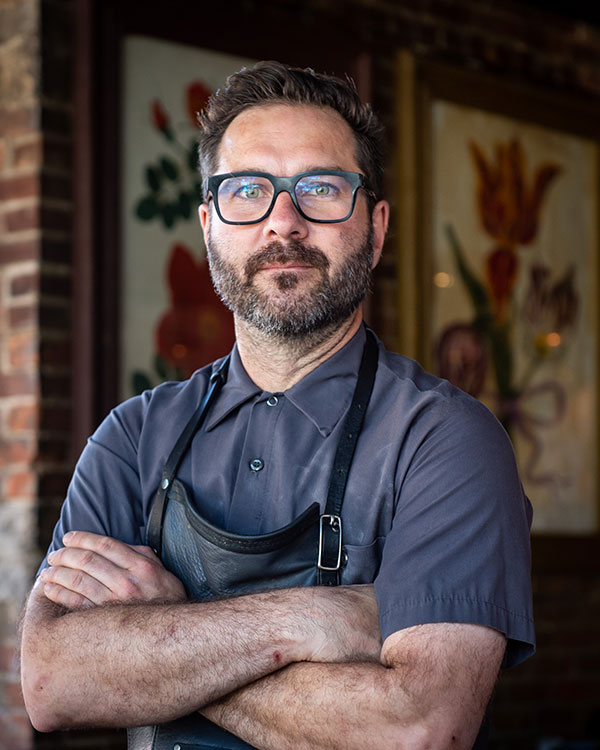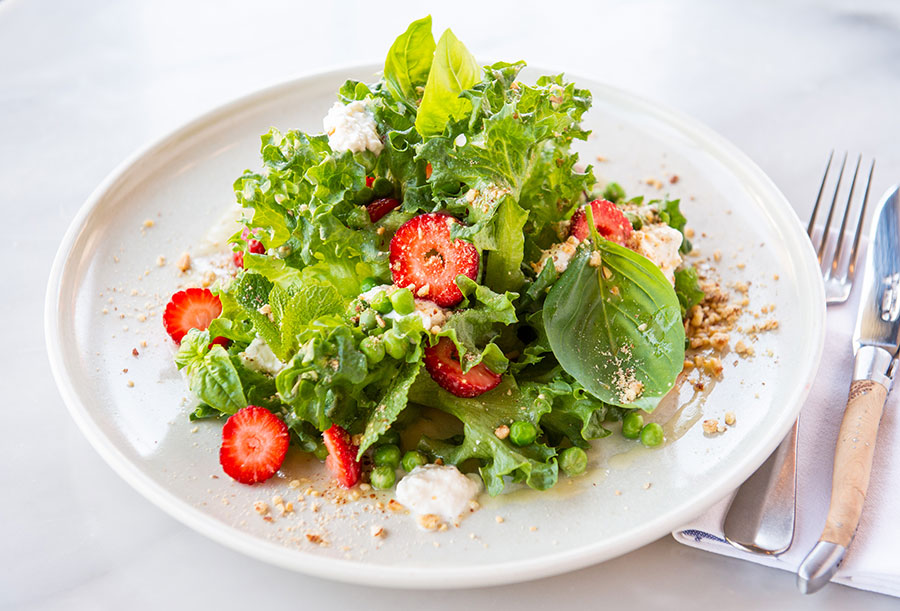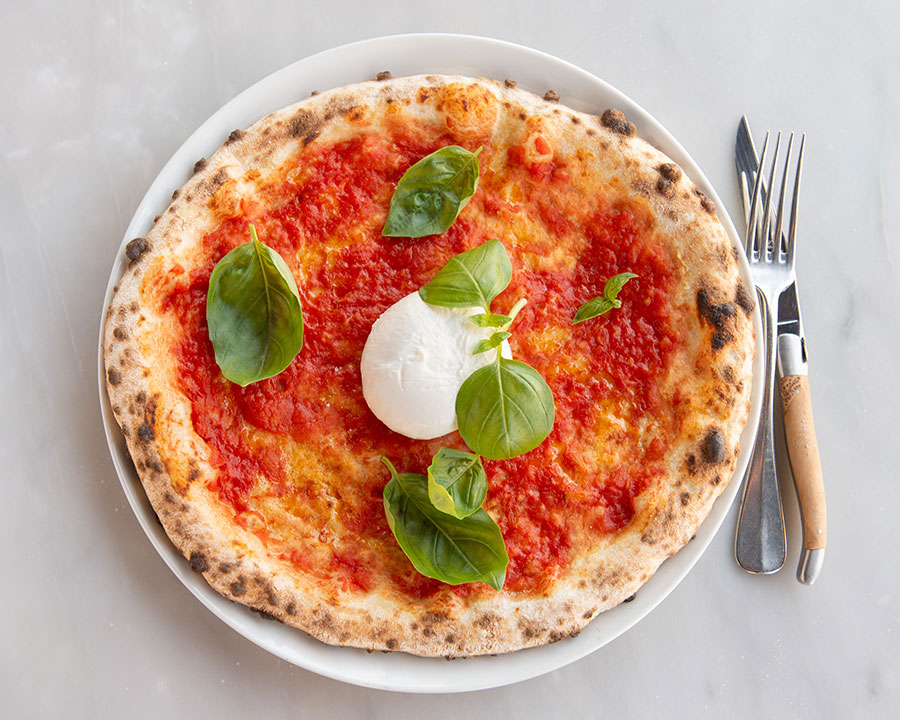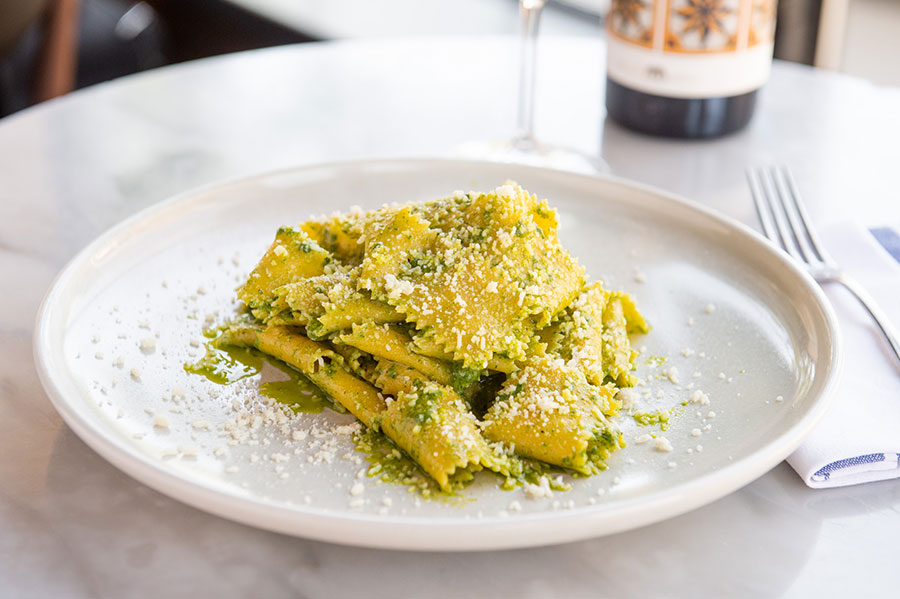A Taste of Italy: Recipes and Culinary Tips From Chef Eron Novalski

We serve up a few of Novalski’s seasonal recipes, including such palate-pleasers as Burrata Piazza (above). Photo: George Pimentel Photography
“Authentic Italian cuisine is rooted in simplicity and the finest, freshest, local ingredients,” says chef Eron Novalski, owner of the popular Toronto eatery, Noce Restaurant.
Known for its old-world flavours and traditional live wood-fire cooking, Noce’s innovative menu features locally sourced foods, including most recently, pesticide-free produce from an innovative state-of-the-art vertical farm in Welland, Ont. In fact, Novalski says the basil grown right here in Ontario is so fresh and flavourful, it takes him right back to Italy.
“My approach to cooking is to always let the ingredients do the talking, so I start with quality, fresh, local and seasonal produce,” he says. “The same goes for meats that are always hormone- and antibiotic-free. I steer clear of mass-produced foods.”
We serve up a few of Novalski’s seasonal recipes, including such palate-pleasers as Burrata Pizza and Pasta Genovese, but first some insider culinary tips from the chef.

Insider Tips: Can you share your favourite flavour boosters — and any other secret weapons?
Finishing salts: A quality finishing salt is a must and a simple staple that can bring out and elevate flavour in savoury and sweet dishes. Whenever a dish is missing something, chances are a finishing salt can do the trick. My all time preferred is Ravida but it can be a little hard to find. I also like Malden (English) sea salt flakes, but France also produces some nice salts.
Finishing oils: My pantry is well stocked with finishing oils from around the world … Italy, Greece, Turkey, you name it. Every country and region produces a uniquely different note. Finishing oils are like wine varietals … each has their own perfect pairing. Lighter oils are great on raw pastas, fish and salads.
Garlic confit: I add smoothly pulsed confit garlic to sauces, soups and dressings. It adds a toasted, nutty flavour and depth, and is less potent and far more subtle than fresh garlic so it doesn’t overpower the delicate flavours of a dish.
Easy Entertaining: What is your go-to dish for cooking for a crowd without the stress?
Italians have been cooking and eating together for centuries. It’s a pillar of sociability but it’s a practice that we don’t adopt nearly enough in North America — especially when it comes to entertaining.
Simple salads, pesto genovese and pasta aglio e olio are always good crowd-pleasers. (Recipes for salad and pesto below.)
Fiorentina steak is a porterhouse cut and incredibly flavourful, lean and tender. You don’t have to do much to it other than add a little salt and pepper before grilling. Serve that up with a grilled veg and your guests are guaranteed to be blown away.
Another of my favourite dishes to cook with friends is a seasonal risotto made with a good stock because it’s fairly simple to do. Crack a bottle of good wine and everyone can get to work.
Must-Haves: What items/ingredients do you keep stocked in your pantry/fridge?
Pasta: I like to make my pasta fresh, but at home I will keep Gragnano pasta on hand. This eponymous pasta is made in a town outside of Naples where they let the sea air dry the pasta. It’s delicious and made from durum wheat, so it holds a pretty good bite.
Cultured butter: A good cultured butter is a must … some of the best are from Italy and France, but Quebec produces some amazing ones too. The flavour and the richness of a good cultured butter puts any mass produced butter to shame and can make all the difference to your cooking. It also turns eating good bread and butter into one of life’s most heavenly yet simplest pleasures.
Cheeses: I love all cheeses — gorgonzola, Parmigiano, you name a cheese, and I’ll eat it.
Garlic: Good, fresh garlic is a kitchen staple. Jarred is sacrilege.
Anchovy: Anchovies are instant umami for so many dishes. I like Callol Serrats from Spain. The best ones you can eat on their own, dissolved in butter and spread on bread.
Wine: Wine is very mood driven, and there’s a lot of good wines out there that are easy-drinking, and not too expensive. My favourite is a good dry white, that’s light-bodied and pairs well with fish, and pasta. You can’t go wrong with a good bianco from Sicily.
Chips: I love all chips in any flavour — jalapeño or ketchup are great but I love a brand called Covered Bridge. They make a flavuor called The Weekender that’s a little addictive … it’s a combination of jalapeño, ketchup, barbecue and dill in one. These with a cold beer are a guilty pleasure for sure.
Cured meats: There’s really no cured meat I will say no to, but if I had to choose it’s prosciutto, or a good cotta salami.
Tuna: I always keep a good Italian tin tuna in oil on hand. It’s great for pastas, or salads.
Caviar: It’s a good treat to have in the fridge from time to time that I love to eat on chips, or bread.
Good olive oil: A light Italian olive is versatile and flavourful. It’s really not something you ever want to cheap out on. Splurge a little if you can.
Finding Comfort: What is your go-to comfort food dish?
Curry: There’s nothing like a good curry — vindaloo, marsala, biryani with chapati and I’m in heaven. Perogies are the second runner-up.
I also love hotdogs too, from J Kwintwer with a hot mustard, like Keens, and onions or sauerkraut.
Snack Attack: What is your favourite snack, healthy and otherwise?
Usually at work, my go-to is a parfait made with a vegan yogurt, with a house-made granola and fresh fruit. It’s tasty and healthy, which is good.
Multigenerational: Favourite dishes to cook with the kids
I’ve been cooking pizza with my niece and nephew. Cookies are also a good place to start showing them the basics … that’s how my mom and grandma started me in the kitchen. They like their cheese pizza, but for me it’s anchovies and pepperoni. I keep it pretty simple with my pies.
This Q&A has been edited and condensed
RECIPES
Genovese Salad With Limoncello Vinaigrette

Ingredients:
Limoncello Vinaigrette
4 tbsp limoncello
2 lemons, zested
Juice of 1 lemon
2 tsp honey
1 cup olive oil
2 tsp white miso paste
Salt and pepper to taste
Salad
1 cup hulled and quartered ripe strawberries
4 cups of a mix of arugula and baby romaine lettuce (chef uses Vision Green Fancy Premium Lettuce mix, but you can also use your favourite brand)
½ cup blanched peas
1 cup fresh basil (chef uses Vision Greens Living Genovese Basil)
½ cup mint
¼ cup toasted hazelnuts (garnish)
125 g burrata
Tsp olive oil
Salt and pepper to taste
Directions:
- Make the dressing. Whisk all ingredients together vigorously in a small bowl (or shake in a covered jar) until emulsified. Taste and season with a pinch of salt and a few twists of pepper, as needed. Place dressing in the fridge until required.
- Toss the salad. Combine all ingredients, except hazelnuts and burrata, in a large bowl.
- Drizzle evenly with the dressing then gently toss until combined.
- Toast hazelnuts in the oven at 325 F for 5-7 minutes. Crush hazelnuts and keep aside for garnish.
- Place burrata in a small bowl, mash with a fork. Drizzle a 1 tsp of olive oil and salt to taste. Pulverize until a creamy texture.
- Serve immediately and enjoy!
Burrata Pizza With Fresh Basil

Ingredients:
Pizza Dough
1 ½ cups warm water
1 tsp dried yeast
2 ¾ cups Caputo flour
1 ¼ cups fine semolina flour
1 ½ tsp salt, Olive oil for the bowl
Pizza
Tomato passata
125 g burrata
Olive oil
Sea salt
Basil
Directions:
- Pour ½ cup of the water into a large bowl and stir in the yeast. Allow it to stand for 10 minutes, then stir in remaining water.
- Combine all the Caputo flour and 1 cup of the semolina flour and mix into the yeast mixture; when it is still rough and soupy looking, stir in the salt.
- Add the remaining semolina flour only if the dough is super soft. You do not want a solid ball of dough but something that is slightly tacky.
- Cover the bowl with plastic wrap and allow it to rise at room temperature overnight until double in size and lots of little holes appear in the dough.
To Make the Pizza:
- Tap down the dough with your hands and try not to manipulate it too much so that lots of air is expelled. Turn the dough out onto a floured surface and divide it in half.
- Have two sheets of lightly oiled parchment paper ready and place 1 sheet on each of two baking sheets. Lift the dough halves with a bench knife and drop in the center of each sheet of parchment paper. Lightly brush the tops of each half with olive oil.
- Let the dough sit for 10 minutes, then gently push and stretch the dough from the center outward with your hands; don’t exert too much pressure as you do this; you want to preserve as many air bubbles as possible.
- When the dough is about 10 inches in diameter, the rim or edges should be higher than the center by 1 inch.
- Add tomato passata and let rise again for 20 minutes. Bake until the edges are deep brown. The center will be softer than the edges. Once out of the oven, transfer to a plate. Add burrata to the center of the cooked dough base, drizzle with olive oil, and add sea salt to taste. Finish by garnishing with fresh basil.
Pasta Genovese

Ingredients:
Pesto Genovese
50 g of fresh basil (about 60/65 leaves)
½ cup of extra virgin olive oil
70 g (½ cup) of Parmigiano Reggiano or Grana Padano
30 g (2 tbsp) of Pecorino Fiore Sardo
2 peeled garlic cloves, 15 g (1 tbsp) of pine nuts
4 or 5 grains of coarse salt
Ice
Instructions:
How to Make Pesto Genovese With a Food Processor
- Dry the leaves very well on a kitchen towel (important: the basil leaves must be very dry) and place them into the food processor with garlic, pine nuts and grated Parmigiano.
- Chop the ingredients coarsely for a few seconds then add salt and Pecorino cheese cut into small pieces. Blend all the ingredients for about 1 minute. Now add extra virgin olive oil. Blend for about 5 minutes, until you’ll get a creamy green pesto sauce. Pesto must not heat up, so be careful to work quickly, using the food processor at minimum speed and at intervals, that is, blend a few seconds, stop and start again.
- Before seasoning your pasta dish, if the pesto is too thick, add 1 or 2 tablespoons of the cooking water; this way you’ll have a warm homogeneous soft pesto sauce. You can even taste Genovese pesto spread on toasted bread, as an appetizer.
How to Make Pesto Genovese With Mortar and Pestle
- After washing the basil leaves, dry them thoroughly on a kitchen towel.
- Place the garlic in a large marble mortar with a few grains of salt and start pounding with the pestle.
- Add the pine nuts and crush them, obtaining a rather coarse mush.
- Add the basil leaves while continuing to gently crush, then add the two grated cheeses and mix everything together.
- Soften the mixture by slowly pouring the oil until you have a homogeneous, creamy consistency, then transfer it to a bowl and finish mixing it with the remaining oil.
A version of this story was published on Sept. 26, 2022
RELATED:
A Taste of Thailand: A Recipe for Grilled Turkey Satay Skewers From Celebrated Chef Nuit Regular
Naramata Magic: A Guide to This Okanagan Valley Town and Wine Region, Plus Recipes